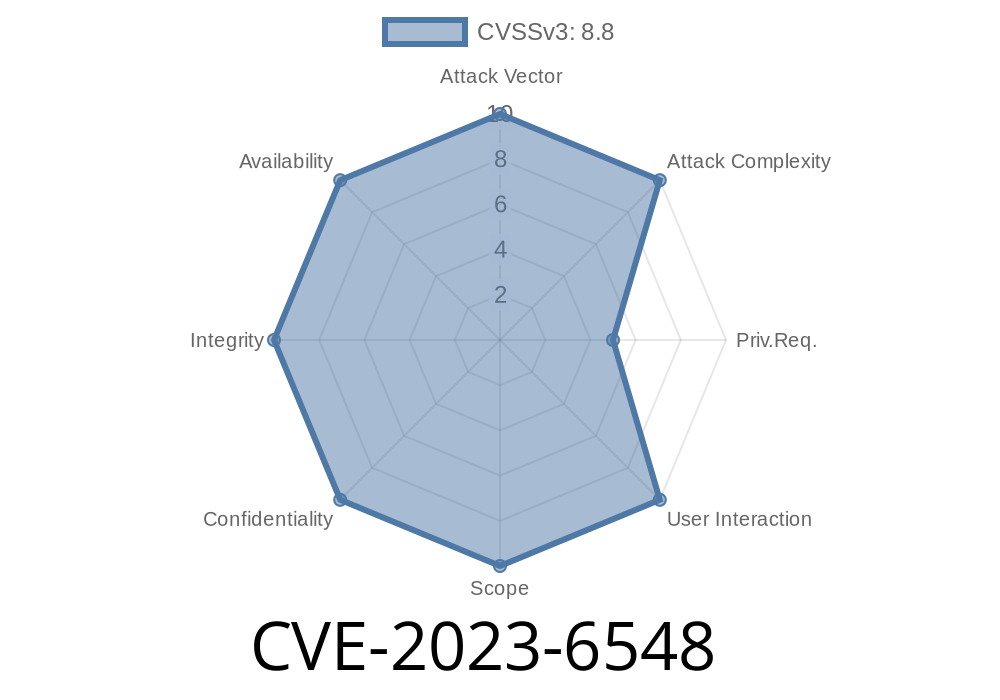A recent vulnerability, indexed as CVE-2023-6548 (https://cve.mitre.org/cgi-bin/cvename.cgi?name=CVE-2023-6548), has been discovered in NetScaler Application Delivery Controllers (ADC) and NetScaler Gateway (https://www.citrix.com/networking/netscaler-adc.html). This vulnerability allows an attacker with access to NSIP, CLIP, or SNIP and management features to execute authenticated remote code on the Management Interface. This code injection attack can lead to unwanted unauthorized access, data exposure, and system compromise.
In this post, we will discuss the details of the vulnerability, demonstrate a code snippet example, and provide mitigation steps. It is crucial to address this vulnerability as soon as possible to ensure the security of your systems.
Vulnerability Details
The vulnerability arises from Improper Control of Generation of Code ('Code Injection') in the affected products. The attacker must have access to the NSIP, CLIP, or SNIP (named IP addresses used in NetScaler) with Management Interface privileges.
An attacker, having low privileged access, can craft and inject malicious code, which will be executed by the management interface. This results in the unauthorized execution of malicious operations, potentially leading to data breaches and system compromise.
The National Vulnerability Database (NVD) rates this vulnerability as having a CVSS v3.1 base score of 7.3 (https://nvd.nist.gov/vuln/detail/CVE-2023-6548). A high score indicates a significant potential impact and the need for immediate patching.
Code Snippet Example
An example of vulnerable code within the Management Interface is shown below
import subprocess
def execute_command(command):
try:
subprocess.check_output(command, shell=True)
except Exception as e:
return str(e)
# Attacker-controlled input (e.g., from an input field in the Management Interface)
malicious_input = ";& cat /etc/passwd" # Code injection attempt
command = "example-command" + malicious_input
result = execute_command(command) # Malicious code is executed
In this example, the attacker-controlled malicious_input is concatenated with a legitimate command. This results in the execution of the malicious code, which in this case, is an attempt to read the contents of the /etc/passwd file.
Mitigation Steps
Citrix has provided a security patch to address the CVE-2023-6548 vulnerability. The patch is available for all supported versions of the NetScaler ADC and NetScaler Gateway products. To obtain the patch, visit:
- Citrix NetScaler ADC download page (https://www.citrix.com/downloads/citrix-adc/)
- Citrix NetScaler Gateway download page (https://www.citrix.com/downloads/citrix-gateway/)
Identify all instances of NetScaler ADC and NetScaler Gateway within your infrastructure.
2. Download the appropriate patch for each identified instance from the Citrix download pages mentioned above, according to your specific software version.
3. Apply the security patch to each identified instance following the official Citrix guidelines described in the release notes/documentation accompanying the patch.
4. After installing the patch, validate that the vulnerability is resolved by running tests and attempting to reproduce the previously exploitable scenario.
5. Monitor your systems and networks for any signs of unauthorized access, data exposure, or system compromise, and take appropriate actions if any anomalies are detected.
Conclusion
Ensuring the security of your systems is of utmost importance, and addressing vulnerabilities like CVE-2023-6548 should be a priority. Follow the provided mitigation steps and promptly apply the security patch to secure your NetScaler ADC and NetScaler Gateway deployments.
Stay updated with the latest information on security vulnerabilities from trusted sources such as the National Vulnerability Database (https://nvd.nist.gov/), and always verify the integrity of patches before applying them.
Timeline
Published on: 01/17/2024 20:15:50 UTC
Last modified on: 01/25/2024 16:45:58 UTC
